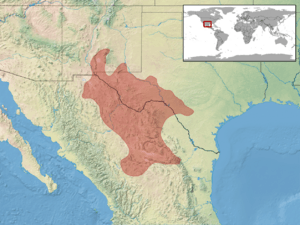Trans-Pecos rat snake facts for kids
Quick facts for kids Bogertophis subocularis |
|
|---|---|
 |
|
 |
|
| Trans-Pecos rat snakes at the Houston Zoo |
|
| Conservation status | |
| Scientific classification | |
| Genus: |
Bogertophis
|
| Species: |
subocularis
|
 |
|
| Synonyms | |
|
|
Bogertophis subocularis, commonly known as the Trans-Pecos rat snake or the Davis Mountain rat snake, is a species of medium to large, nonvenomous rat snake in the family Colubridae. Bogertophis subocularis is endemic to the Chihuahuan Desert.
Geographic range
The Trans-Pecos rat snake is found in the Mexican states of Chihuahua, Coahuila, Durango, and Nuevo León, and its range extends northward into Texas and New Mexico in the United States.
Description
B. subocularis has a row of small scales (suboculars) between the lower border of the eye and the upper labials. Coloration is yellow to tan dorsally with a series of black, or dark brown, H-shaped markings. The eye is large and prominent, light-colored with a contrasting round black pupil. The tongue is pink. The dorsal scales are in 31-35 rows at midbody. The ventrals number 260-277; the subcaudals number 69-79.
Adults are usually 36-54 inches (90–137 cm) in total length (including tail). The record total length is 66 inches (168 cm).
Habitat
The Trans-Pecos rat snake's habitat consists of desert flats and brushy slopes, and rocky outcrops where it dens.
Diet
B. subocularis feeds on small vertebrates.
Behavior
A nocturnal species, B. subocularis is uncommon and rarely seen in the wild, save on warm summer nights during the breeding season. Nicknamed "suboc" by enthusiasts, it is nonaggressive when approached, even passive, and is easily raised in captivity.
Reproduction
The breeding season for B. subocularis runs through May and June, while egg-laying begins in July and ends by September. At nearly three months, their incubation period is lengthy for a snake, at the end of which a clutch of anywhere from three to 11 snakes, each 28–33 cm (11–13 in) in total length, hatch. As they are hatched during winter, the hatchlings may remain hidden underground for several months before venturing outside.
- Brown AE (1901). "A New Species of Coluber from Western Texas". Proc. Acad. Nat. Sci. Philadelphia 53: 492-495 + Plate XXIX. (Coluber subocularis, new species).
- Rhoads, Dusty (2008). The Complete Suboc - A Comprehensive Guide to the Natural History, Care, and Breeding of the Trans-Pecos Ratsnake. Lansing, Michigan: ECO Herpetological Publishing & Distribution. 291 pp. ISBN: 978-0978897956.
- Stebbins RC (2003). A Field Guide to Western Reptiles and Amphibians, Third Edition. The Peterson Field Guide Series ®. Boston and New York: Houghton Mifflin Company. xiii + 533 pp. ISBN: 978-0-395-98272-3. (Bogertophis subocularis, p. 360 + Plate 45 + Map 150).
- Stejneger L, Barbour T (1917). A Check List of North American Amphibians and Reptiles. Cambridge, Massachusetts: Harvard University Press. 125 pp. (Elaphe subocularis, new combination, p. 84).
- Tennant, Alan (1998). A Field Guide to Texas Snakes, Second Edition. Houston, Texas: Gulf Publishing Company. pp. 200–201.
- Species Bogertophis subocularis at The Reptile Database


